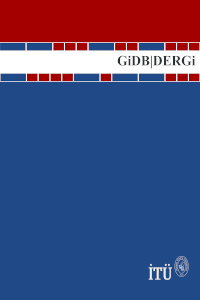ANALYSIS OF SECOND GENERATION INTACT STABILTY CRITERIA
2. nesil yarasız stabilite kriterleri olarak adlandırılan IMO’nun yeni stabilite kuralları beş adet hata
modundan oluşmaktadır: Net stabilite kaybı, Parametrik yalpa, Dalga üstünde seyir ya da boşa çıkma, Sevk sistemi devre dışı kalmış gemi durumu ve aşırı ivmelenme. Bu kriterler güvenlik ve hassasiyet analizlerini içermektedir. Bu makalede, bir yük gemisi için özellikle net stabilite kaybı ve parametrik yalpa hata modları incelenmiştir.
Anahtar Kelimeler:
parametrik yalpa, net stabilite kaybı, 2. nesil yarasız stabilite kriterleri, dökme yük gemisi stabilitesi
ANALYSIS OF SECOND GENERATION INTACT STABILTY CRITERIA
A new Intact Stability Code that is called second generation intact stability criteria are likely to be issued by IMO. These criteria include five failure modes of stability vulnerability (pure loss of stability, parametric roll, surf riding/broaching, dead-ship and excessive acceleration). The paper presents sample calculations concerning the assessment of the vulnerability to parametric roll of a bulk carrier. Calculations are carried out for level 1 and level 2 of the criteria under consideration. There are two options for assessment of criteria in Level 2. C1 of Level 2 is used in calculation given in this study.
Keywords:
parametric roll, pure loss of stability, second generation intact stability criteria, stability of a bulk carrier,
___
- [1] Resolution a.749 (18), (1993),Code on intact stability, International Maritime Organization (IMO)
- [2] Resolution a.167 (ES.IV), (1968), Recommendation on intact stability for passenger and cargo ships under 100 meters in length, International Maritime Organization (IMO)
- [3] Resolution MSC.267 (85), (2008), International code on intact stability IS code, International Maritime Organization (IMO)
- [4] SLF 48/21, (2005), Report to the maritime safety committee, Sub-committee on stability and loadlines and on fishing vessels safety, International maritime organization (IMO)
- [5] SLF 49/5/2, (2006), Revision of the intact stability code: Proposal of a probabilistic intact stability criterion, Sub-committee on stability and loadlines and on fishing vessels safety, International maritime organization (IMO)
- [6] SLF 51/4/4, (2008), Revision of the intact stability code: Further proposal for so-called new generation intact stability criteria, Sub-committee on stability and loadlines and on fishing vessels safety, International maritime organization (IMO)
- [7] SLF 53/3/5, (2010), Development of new generation intact stability criteria: Comments on the structure of new generation intact stability criteria, Sub-committee on stability and loadlines and on fishing vessels saftey, International maritime organization (IMO)
- [8] SDC 2/WP.4, (2015), "Development of second generation intact stability criteria", Report of the working group (part 1), International maritime organization (IMO)
- [9] International Code on Intact Stability, (2008), International maritime organization (IMO)
- [10] Umeda, N., Francescutto, A., 2016, “Current state of the Second Generation Intact Stability Criteria – Achievements and remaining issues”, Proceedings of the 15th International Ship Stability Workshop (ISSW2011), 13-15 June 2016, Stockholm, Sweden.
- [11] Peters, W., Belenky, V., Bassler, C., Spyrou, K., Umeda, N., Bulian, G., Altmayer, B., 2011, “The Second Generation Intact Stability Crietria: An overview of development”, Annual Meeting of the Society of Naval Architects and Naval Engineers, Vol. 121, SNAME, Houston, Texas.
- [12] Reed, M.C., 2009, “A naval perspective on ship stability”, 10th International Conference on Stability of Ships and Ocean Vehicles (STAB2009), St. Petersburg, Russia, pp.21-44.
- [13] Belenky, V., J. O. de Kat & N. Umeda (2008) “Towards Performance-Based Criteria for Intact Stability.” Marine Tech., 45(2):101–123.
- [14] IMO SDC6/5, (2019), “Finalization of second generation intact stability criteria”, Submitted by Japan.
- [15] Gonzalez M.M., Casas V.D., Agras D.P., 2013. “Investigation of the Applicability of the IMO Second Generation Intact Stability Criteria to Fishing Vessels”, University of A Coruña.
- Başlangıç: 2015
- Yayıncı: İstanbul Teknik Üniversitesi
